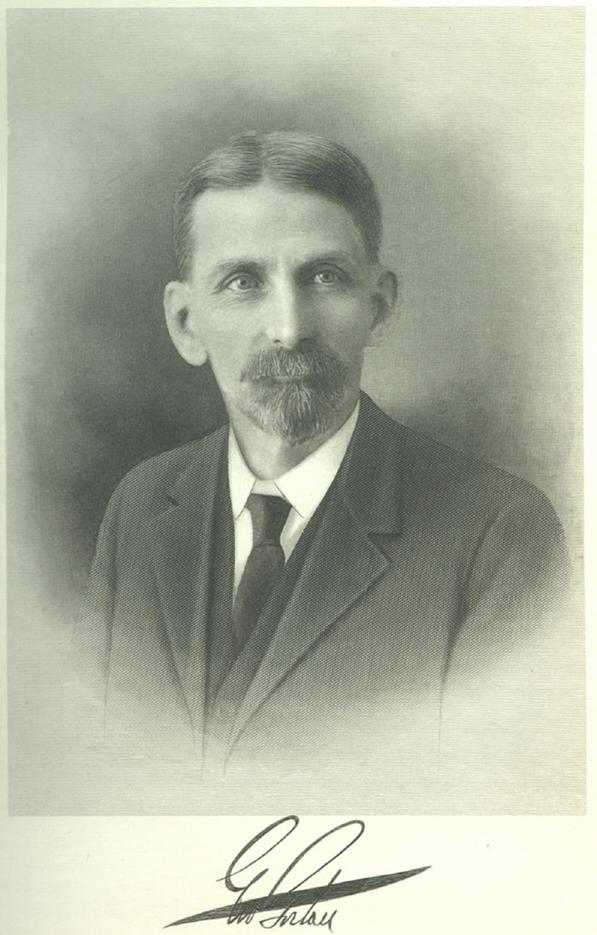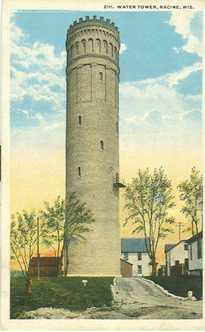
 |
| George Gorton II, circa 1916 |
|---|
| George II's family & children | |
| March 4, 1897 | Katherine Bishop (1897 - 19??) born in Luzerne, Pennsylvania |
| Nov. 28, 1900 | George II marries Sophy Thorstenson |
| March 14, 1902 | George III (1902 - June 12, 1988) born |
| Dec 2, 1904 | Elizabeth Fry (1904 - Oct. 1988) born. |
| Feb 7, 1909 | Fraternal twins Charles (1909 - March, 1970) and James (1909 - 1962) born. |
| Oct 27, 1930 | Sophy dies in Racine |
| Feb 1, 1935 | George II marries Katherine Bishop. I (author of this web site) remember hearing her referred to as "Aunt Katherine". |
| General biographical timeline (prior to George Gorton Machine Co.) | |
| 1845 | George I emigrates to Kenosha, WI (then called 'Southport') |
| 1846 | George I moves to Racine, WI and becomes partner in the firm of Thorpe and Gorton, druggists. According to one account, one thing unusual about this business was that they exported butter to England. |
| Oct 16, 1862 | Ann Buffham dies in Racine. Survived by George I and daughters Minnie, Eliza, and Anne |
| May 9, 1864 | George I marries Ann's sister Elizabeth |
| Feb 5, 1865 | George Gorton II born in Racine, Wisconsin |
| 1867 | George I packs up the family (except for George II) and returns to England, to puchase a house. They purchase a house at Douglas, Isle of Man. George II stays with his grandmother Buffham in Milbourn, IL. until they return to move everything to Douglas. |
| 1868 | George I and family returns to Racine. George I opens Buffham's paint shop with his brother-in-law, William S. Buffham |
| 1870 or 1871 | The Thorstenson's emigrate to the United States, taking up residence in Racine. |
| June, 1871 | William Buffham, grandfather of George II dies. George II records that as a child, he was fascinated and deeply influenced by William, who made microscopes and instruments. |
| 1874-1875 | George II builds his first machine - a wood lathe. It was wind powered, made completely out of wood, and used tallow to lubricate the bearings. It was wiped out by a heavy windstorm just after being completed. |
| May 5, 1882 | Great Racine fire - more than 40 factories, warehouses and retail establishments burned |
| 1884-1888 | George II teaches mechanical drafting at YMCA for some period of time |
| June 14, 1888 | George Gorton I dies in Racine, due to "over work and a nervous breakdown caused by worry over a business transaction which put him considerably in debt through no fault of his own." George II takes over the (then) family basket-making business. Business is listed as employing more than 200 people |
| 1888 - 1893 | George II works for basket company as a salesman; eventually forced out by "a certain individual who wanted to acquire the now profitable basket factory." George II, along with Fred Graham. |
| History of Gorton Machine Co. | |
| 1893 | Gorton & Graham Machine Co. formed, with initial capital of $-1000.00 (yes, started with a debt) in the Gorton backyard greenhouse, dimensions 12' x 15'. Brother Charlie joins George & Fred, but both Fred and Charlie leave to get jobs which pay. |
| 1893 | George Gorton Machine Co incorporated. Some of the first products were wood and brass patterns. Also designed and built were "splint basket making machinery, a basket handle and bail fencing machine, an handle notching and pointing machine, a splint cutting machine, a scarfing machine, and plain and universal gang saws." |
| mid-1890s | George II designs and builds an early refrigeration prototype, improved coal stoves (one of which was rediscovered still in use in the mid 1940's), a gasoline container (gasoline was commonly used as an industrial solvent at the time) which had a (safety) fusible link to hold the cover up, and a glue pot |
| same timeframe | Cousin Bill McAllister challenges George II to build a disc grinder; Bill thinks George II can build a better one than being built by Charles Besley. Besley is apparently selling quite a few of them. George II takes up the challenge |
| 1897 | As a favor to Fred Graham, George designs a brick enclosure for the
330,000 gallon town water 'standpipe'. Fred submits the design, and wins the
building contract. This postcard (circa 1920s) is of a Racine water tower,
presumably the same (only?) one owned by the town.
George's memoirs indicate this tower is
located just east of nortwestern rr, and north of 10th st. One of the
volunteers at the
Racine Heritage Museum
recalled this water tower from her childhood.
|
| 1898 | Battleship Maine blows up; Spanish-American war. A friend inquires with George about making molds for souvenirs/commemoratives of the Maine sinking. George orders a pantograph from Taylor, Taylor and Hobson of Leicester, England, and subsequently acquires US Patent rights to their design. Sells first improved pantograph, the 1-A, to Western Electric of Chicago. Price: about $325.00 |
| 1890's | George starts designing cutting-off machines (for bar steel) with internal teeth. Supposedly, 15-20 patents issued for components of this machine, with some going back to 1892 |
| 1899 | George II starts advertising disc grinders in machinery trade papers |
| April, 1900 | Paris Industrial Exposition held; Gorton Machine earns a bronze for excellence in design of disc grinding equipment |
| 1900 | First product catalog (all grinding machines) of 40 pages published |
| 1900-1901 ish | George II and an employee named Carpenter (patent co-holder??) build a prototype engine in preparation for getting into automobile business. George gets cold feet after reading about all of the companies entering the business |
| 1903 | George II informed that he has 6 months to live, due to an extremely bad kidney infection. A major change in diet helps; George recovers |
| 1903 | Sale of disc grinding business to the Diamond Machine Company. Apparently, Diamond lets the disc grinders languish. |
| 1906 | George designs a disc making machine for making either paper or cloth discs coated with sand or emery grit. |
| 190? | George designs a placer mining machine; memoirs imply patents, investigation shows nothing. |
| 1906-1908 | George works on designing and building a machine to fold, wrap, and address printed material automatically for an unnamed company. The machines fail to sell, and goes out of business. |
| 1906-1907 | Rotary Broaching Machine. Through contact with Kelly Axe Company of Charleston, West Virginia, George designs a rotary broaching machine |
| 1909-ish | 1-D, 1-G, 1-J and finally 1-S pantographs designed and built |
| 1909 | Gorton Gate and Fence Company of Waukegan, Ill. started. As part of this, worked with George Tausch of the Cyclone Fence Company; designed a machine to 'weave' cyclone fences. Took out a patent on the machine. A number of years later, was offerred $1000.00 for that patent. |
| before WWI | Comments about solving all problems except financial; in debt to the tune of $75,000! |
| 19?? pre-WWI | Sold cutoff machine to American Locomotive Works |
| Early WWI | Sold more cutoff machines to Allis-Chalmers of Milwaukee. This leads to a multiple machine sale to Dominion Iron and Steel Co of Montreal |
| 19?? | Three different sizes of cutting off machines developed: 3", 6", and 13". Production of internal tooth cutting off machines ends in 1924. |
| 1916 | A Racine area book is published with about two pages of biographical information about prominent locals. George II is in it, and given the level of detail about the Gorton Machine cutting-off machinery, it was written by him, or with a lot of input from him. A company description (in volume 1 of the same book) indicates that at that time, the company employed about 50 men; was made into a corporation in 1895; officers of the company are George, president and treasurer; and S. Gorton (Sophy), vice-president. |
| 1917-1918 | George & Sophy, active in the First Baptist Church of Racine, decide to donate a building to their church out of the profits from building war machinery (presumably fuse routers, possibly cutoff machines). The initial donation is $50,000, but (based upon information in George III's book 'A "Big-Ass Boy" In the Oil Fields') this was overrun by another $86,000; George and Sophy 'cheerfully' covered this. The building was capable of seating 500, had a gymnasium, two bowling alleys, a ladies parlor, and a gentlemen's lounging room. The church named it 'Gorton Hall'; it was torn down in 2004. |
| 1917-1927 | George & family spend much of their time living in Oklahoma,
with some time in Racine. Company mostly being run by ???. According to
George III's book, at one point a representative from Shell Oil offered
George II $1Million to buy his oil rights and property. George II turned
this down, believing that the rights were worth more. Based upon George II's
memoirs, the whole adventure in Oklahoma was a financial disaster.
The Gorton Trust was the business trust
to prospect for oil and gas.
|
| Feb. 6, 1943 | The Army-Navy 'E' flag, for excellence in war production work is presented to the company and employees. By the end of the war, 5 stars had been added, signifying that the production rate stayed high. George II was very proud of this award. |
| 1943 | 50th Anniversary of the Company. |
| 1947 | Gormac Products, Inc. spun off |
| 1955 (??) | This photo of George II taken. Quite possibly
one of the photos taken about a month before he died in 1955.
 |
| 196? | Company sold to Kearney & Trecker. Subsequently becomes Cross & Trecker. At some point, I believe Cross & Trecker went bankrupt, with the Patents being assigned to Citicorp. Eventually, Cross & Trecker is then purchased by Giddings & Lewis, which in turn is acquired by Theissen & Co. |
| 197? | Lars Machine founded by Charles A. Larsen, formerly a VP of Gorton. Lars manufactures cutter-grinders and pantographs |
| 1975 | George Gorton III publishes his Oklahoma memoirs. Tidbits about George II include that he liked Piper Heidsick plug tobacco |
| 2004 | Richard Gorton starts this web site. Relation is: George II --> Charles --> Richard Sr. --> Richard Jr. |
Copyright, 2004 - 2015 Richard Gorton - rcgorton@verizon.net
Please contact me if you wish to use images or content herein